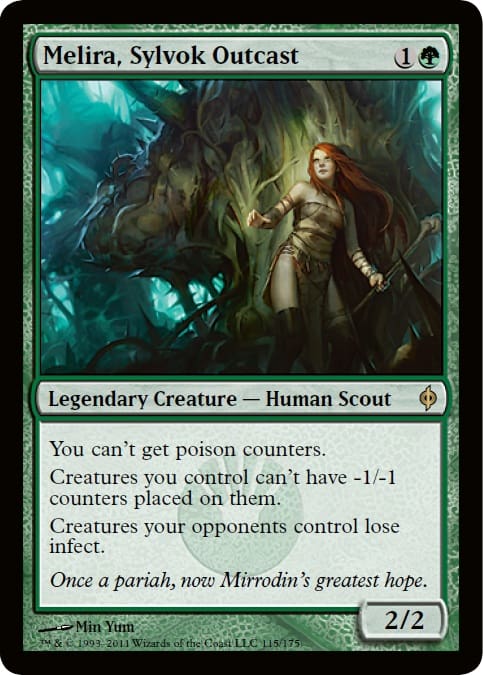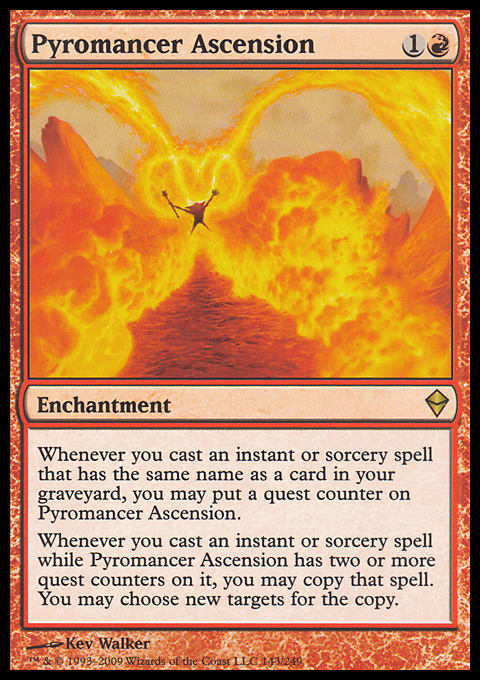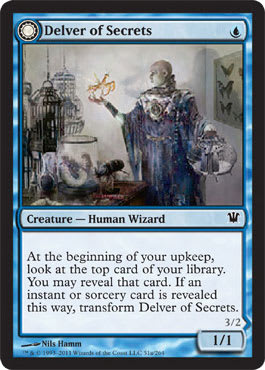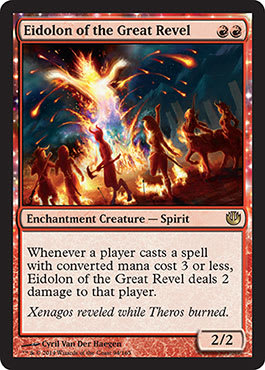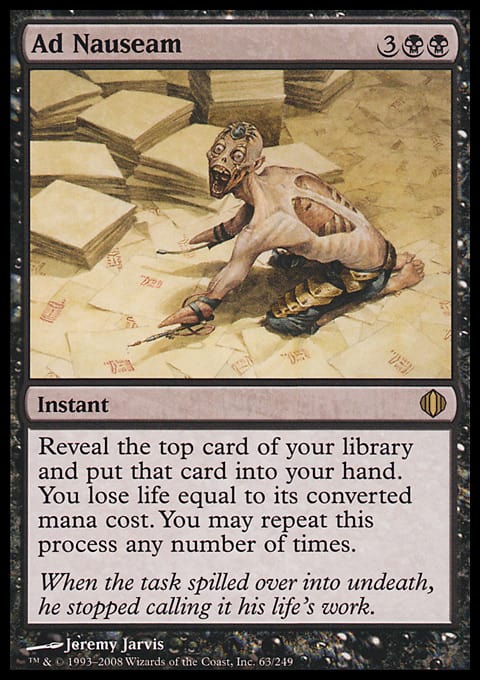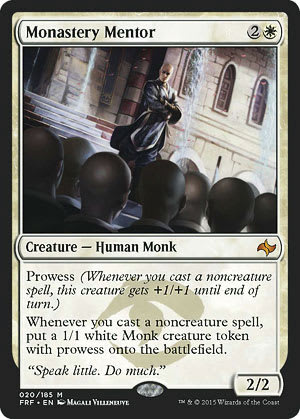Last week, a friend of mine announced her decision to attend her first Grand Prix. After a year and a half of playing in casual store events and prereleases, she’s deciding to take her first step into the competitive world by registering for the main event in Vancouver later this month—which, by the way, is Modern, a format she has never played before. She posted on a public forum asking for advice on learning the format, and several helpful people referred her to podcasts, primers, decklists, and other resources.
As you may remember from my article on playing in your first Grand Prix, I also started my competitive Magic career by playing Modern and got in way over my head. Like my friend, I spent hours poring over Modern Daily Event decklists on the Magic Online website, trying to figure out how decks like Storm and Melira Pod (R.I.P.) combo’d off. I spent a lot of time thinking about Modern and very little time actually playing. That’s why I advised my friend to build a deck—any deck—and take it to a local Modern tournament as soon as possible.
Unfortunately, it isn’t always easy to find places to play Modern. Not many local shops offer it, and those that do prioritize more popular formats like Standard and Booster Draft. (One store here in Seattle only offers Modern every other week; another relegated the format to a Saturday-evening time slot.) Often, for competitive players and aspiring ones, the best option is to build a deck on Magic Online and spend hours upon hours grinding matches, but investing in a deck upfront may present too much of a risk for someone with little experience with the format.
Alternately, you could build a gauntlet—a collection of decks for testing and evaluating a given format. Gauntlets are fantastic tools for preparing for events, learning metagames, and teaching others how to play Magic. I’ve met several gauntlet-owners in my time, and they often remind me of Cube curators: They take pains to update their decks with every new set release and banned-and-restricted announcement, and each person’s deck collection is somehow unique. Eternal-format diehards spend years acquiring staples, building enough Legacy or Vintage decks to run a small, sanctioned tournament. History buffs recreate the most powerful Standard decks of all time and pit them against each other to decide which era of Magic had the most overpowered cards. Community-builders have boxes of simple, straightforward decks on hand for teaching the game to newcomers; one of my friends has a suitcase full of Commander decks that he lends out during his regular game nights.
As for me, I have a library of Modern decks because I was dissatisfied with my playgroup’s testing rituals for Modern tournaments. Two years ago, when I started playing competitively, my playgroup would come together once or twice the week before a major event and do some testing. Everyone brought the deck he or she was planning on playing in the event, and we all just took turns playing against each other. Some members of the group had already logged countless hours with their chosen decks on Magic Online, but others just showed up with a deck and hoped that a couple hours of playtesting would be sufficient preparation. However, our playgroup’s metagame wasn’t always representative of the tournament we were training for—even when we had six players piloting six unique decks, we always seemed to be missing something important.
Over time, we grew wiser and started putting out calls for people to bring specific decks to practice. Someone had to bring Mono-Black if we were testing Standard, or Pod if we were playing Modern. This leads me to one of the biggest issues that I’ve seen in playtesting: No one ever wants to take one for the team and pilot the “bogeyman” deck. I once spent an afternoon testing Modern with a friend and ended up handling every deck in my gauntlet while he stuck with the deck he wanted to play. In the long run, my willingness to play anything in testing has helped me become a more adaptable Magic player—I have an easier time picking up a deck and learning it on short notice—but it has cost me dearly in the short term, as I’ve always been less prepared for a tournament than my teammates, who got more reps in with their decks of choice. If you want everyone in your playgroup to be adequately prepared, try setting a simple ground rule, e.g. “each member of the group must play at least one deck from the gauntlet.”
Setting Up Your Gauntlet
Think you want to build a gauntlet of your own? I’ll share the steps I took to assemble my Modern deck collection and start putting it to use. This advice is intended for competitive formats only; if you’d rather create a casual gauntlet, leave a comment below, and I’ll do my best to help.
1 — Consult Your Playgroup
The needs of your playgroup will dictate what kind of gauntlet you build and which decks you include, so get together with some friends and have a discussion about what you’d like to play. Are you trying to solve the Standard metagame before the upcoming Grand Prix or Pro Tour? Or do you want to work together to learn an entirely new format, like Legacy? Decide on a plan of action, and arrange to meet regularly to practice.
2 — Research the Format
Your testing gauntlet should include at least half a dozen of the most powerful and prominent decks in a format. If you’re new to that format or don’t follow coverage regularly, you may need to do some extra legwork to figure out which decks you should be trying to beat. Check the results of recent Grand Prix, Pro Tours, StarCityGames Opens and Premier Invitational Qualifiers, and Magic Online events for ideas; mtgtop8.com is a great resource as well.
If you intend to test your own brews against the gauntlet decks, you’ll want to make sure a variety of archetypes is represented. My Modern deck collection includes two aggressive decks (Affinity, Burn), a midrange deck (Abzan), a control deck (Jeskai Flash), and two combo decks (Temur Twin, Storm); I’ll only consider playing a Modern deck that matches up favorably against at least four of the six. When I eventually build a Legacy gauntlet, it will probably include at least one Delver deck, a Stoneforge deck, Miracles, Death & Taxes, Sneak & Show, Storm, and Burn. You might find it odd that I’ve chosen to include Burn in both of these lists, but let’s face it: Burn is the most affordable competitive deck in any Eternal format, so it’s very likely that you’ll face it at least once on Day 1 of a Modern or Legacy Grand Prix. Mono-Red decks apply a tremendous amount of pressure, and Eidolon of the Great Revel has given Burn players a newfound edge against combo. If your deck can’t withstand an onslaught of Lightning Bolts, consider playing something else.
Standard gauntlets are harder to build, especially in freshly-rotated and uncertain metagames—but I suppose that’s all part of the fun. If you and your playtest partners aren’t sure what’s good in Standard, take a page out of the pros’ playbooks and brew up a gauntlet of your own. When building your Standard decks, think less about archetypes and more about the potential of specific cards. (Don’t think, “Let’s see if Monastery Mentor works in this shell,” but, “Let’s build the best possible shell for Monastery Mentor.”)
Another thing to keep in mind, regardless of which format you’re playing, is to build seventy-five-card decks, not sixty-card decks. I have certainly fallen into the trap of not building a sideboard for playtesting. “I’ll figure out what I need for my sideboard after playing against other decks,” I used to tell myself. In an actual tournament, however, between one half and two thirds of your matches will take place after sideboarding, so logic would dictate that you should sideboard for one half to two thirds of your playtesting matches. Put together a fifteen-card sideboard that shores up your worst expected matchups, and if you can’t narrow it down that far, bring some extra cards along to try out.
3 — Build the Decks
Once you’ve settled on the decks for your gauntlet, you’ll have to acquire the cards to build them. In this regard, a Standard gauntlet is the easiest to build—you’ll probably have plenty of Standard-legal cards lying around after all those Drafts you did, and if you’re missing some pieces, they shouldn’t be too hard to come by. Modern and Legacy are trickier, as the card pools are much larger, and format staples that haven’t been printed in years (and that may never be reprinted, thanks to the reserved list) can be costly. If building half a dozen Modern decks isn’t financially feasible for you, I recommend pooling your resources with your playgroup. Build a shared deck library with your friends for all to use—or delegate for each member of the group to build a deck that is within his or her means.
4 — Update the Decks
For me, the most difficult part about owning a Modern deck library is maintaining it. Just a month ago, my gauntlet included U/R Delver, Birthing Pod, and a Splinter Twin deck that ran a few copies of Dig Through Time; the most recent banned-and-restricted announcement rendered them all (at least partially) obsolete. Modern is a malleable format, and maintaining a library of top-tier decks can be a huge undertaking, but it’s a challenge I’m willing to accept. Update your Modern gauntlet whenever a new set comes out, or whenever Wizards issues a new banned-and-restricted announcement; for Legacy gauntlets, make changes whenever special sets, à la Commander and Conspiracy, hit the market.
Until next time, happy playtesting!
















